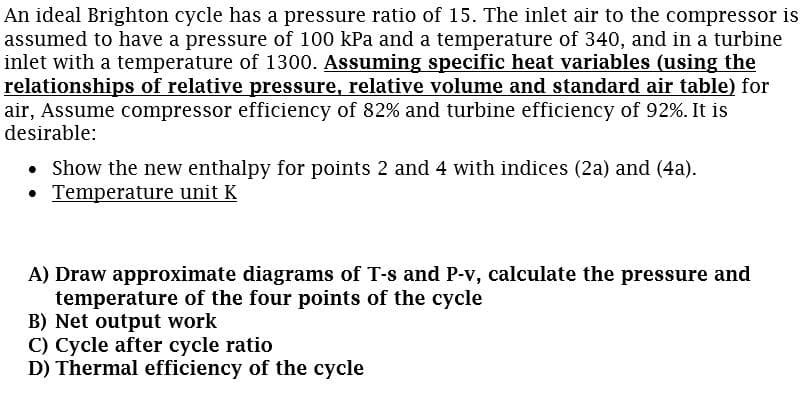An ideal Brighton cycle has a pressure ratio of 15. The inlet air to the compressor is assumed to have a pressure of 100 kPa and a temperature of 340, and in a turbine inlet with a temperature of 1300. Assuming specific heat variables (using the relationships of relative pressure, relative volume and standard air table) for air, Assume compressor efficiency of 82% and turbine efficiency of 92%. It is desirable: • Show the new enthalpy for points 2 and 4 with indices (2a) and (4a). • Temperature unit K
An ideal Brighton cycle has a pressure ratio of 15. The inlet air to the compressor is assumed to have a pressure of 100 kPa and a temperature of 340, and in a turbine inlet with a temperature of 1300. Assuming specific heat variables (using the relationships of relative pressure, relative volume and standard air table) for air, Assume compressor efficiency of 82% and turbine efficiency of 92%. It is desirable: • Show the new enthalpy for points 2 and 4 with indices (2a) and (4a). • Temperature unit K
Elements Of Electromagnetics
7th Edition
ISBN:9780190698614
Author:Sadiku, Matthew N. O.
Publisher:Sadiku, Matthew N. O.
ChapterMA: Math Assessment
Section: Chapter Questions
Problem 1.1MA
Related questions
Question
S3

Transcribed Image Text:An ideal Brighton cycle has a pressure ratio of 15. The inlet air to the compressor is
assumed to have a pressure of 100 kPa and a temperature of 340, and in a turbine
inlet with a temperature of 1300. Assuming specific heat variables (using the
relationships of relative pressure, relative volume and standard air table) for
air, Assume compressor efficiency of 82% and turbine efficiency of 92%. It is
desirable:
• Show the new enthalpy for points 2 and 4 with indices (2a) and (4a).
• Temperature unit K
A) Draw approximate diagrams of T-s and P-v, calculate the pressure and
temperature of the four points of the cycle
B) Net output work
C) Cycle after cycle ratio
D) Thermal efficiency of the cycle
Expert Solution
This question has been solved!
Explore an expertly crafted, step-by-step solution for a thorough understanding of key concepts.
Step by step
Solved in 7 steps with 2 images

Knowledge Booster
Learn more about
Need a deep-dive on the concept behind this application? Look no further. Learn more about this topic, mechanical-engineering and related others by exploring similar questions and additional content below.Recommended textbooks for you

Elements Of Electromagnetics
Mechanical Engineering
ISBN:
9780190698614
Author:
Sadiku, Matthew N. O.
Publisher:
Oxford University Press

Mechanics of Materials (10th Edition)
Mechanical Engineering
ISBN:
9780134319650
Author:
Russell C. Hibbeler
Publisher:
PEARSON

Thermodynamics: An Engineering Approach
Mechanical Engineering
ISBN:
9781259822674
Author:
Yunus A. Cengel Dr., Michael A. Boles
Publisher:
McGraw-Hill Education

Elements Of Electromagnetics
Mechanical Engineering
ISBN:
9780190698614
Author:
Sadiku, Matthew N. O.
Publisher:
Oxford University Press

Mechanics of Materials (10th Edition)
Mechanical Engineering
ISBN:
9780134319650
Author:
Russell C. Hibbeler
Publisher:
PEARSON

Thermodynamics: An Engineering Approach
Mechanical Engineering
ISBN:
9781259822674
Author:
Yunus A. Cengel Dr., Michael A. Boles
Publisher:
McGraw-Hill Education

Control Systems Engineering
Mechanical Engineering
ISBN:
9781118170519
Author:
Norman S. Nise
Publisher:
WILEY

Mechanics of Materials (MindTap Course List)
Mechanical Engineering
ISBN:
9781337093347
Author:
Barry J. Goodno, James M. Gere
Publisher:
Cengage Learning

Engineering Mechanics: Statics
Mechanical Engineering
ISBN:
9781118807330
Author:
James L. Meriam, L. G. Kraige, J. N. Bolton
Publisher:
WILEY